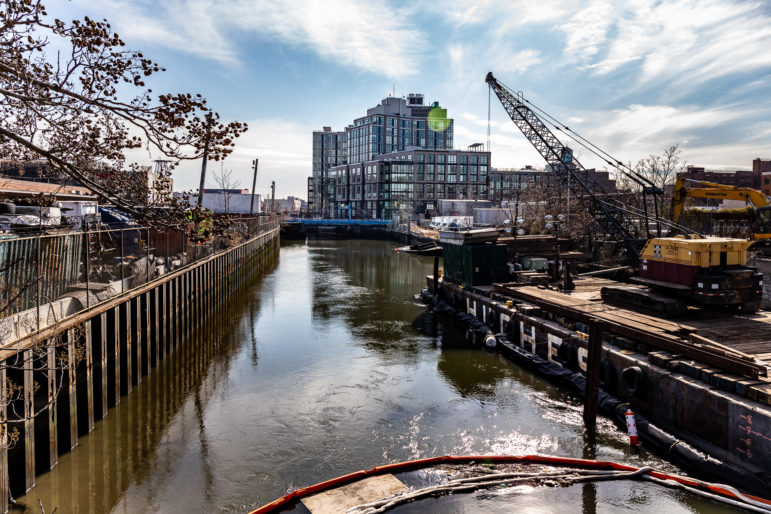Sewer capacity is a vital concern for residents and stakeholders in Gowanus, where the city is proposing a neighborhood rezoning. The new rule helps but doesn’t go far enough, some locals say.

Adi Talwar
Looking South from the Union Street Bridge over the Gowanus Canal.The city outlined its infrastructure plans for the Gowanus rezoning at a Brooklyn Community Board 6 meeting Wednesday, which include new rules to deal with stormwater runoff, school capacity and subway station upgrades.
The plans are intended to help offset the impact of the proposed rezoning, which city officials say could bring an estimated 18,000 new residents to the Gowanus neighborhood. That population increase would mean more waste entering the sewer system, generating an estimated 1.253 million additional gallons per day, according to the city’s Department of Environmental Protection.
Sewer capacity is a vital concern for residents and stakeholders in Gowanus, where the canal is already a highly-polluted Superfund site that the federal government is in the process of remediating. Gowanus, like many other parts of the city, uses a combined sewer system, where both stormwater and sanitary wastewater travel in the same pipe to a treatment plant. When it rains heavily, the system is overwhelmed, causing excess rain and sewage to overflow into waterways or in the case of Gowanus, the canal.
“We have those heavier rainfalls [then] we have the system overloading itself and relieving itself at the combined sewers,” Angela Licata, DEP Deputy Commissioner of Sustainability.
To address these incidents of combined sewer overflows (CSOs), city officials introduced a new rule that would apply to construction occurring under the Gowanus rezoning plan, as well as citywide. The new Unified StormWater Rule (USWR) would apply to projects on lots sized 20,000 square feet or more, and would require developers to install a detention tank which could capture more than the 10-year rainfall and with a one-inch maximum diameter for the detention tank’s orifice, where water would exit–all of which would lead to greater retention and a slower release of stormwater into the canal. Developers’ sites would have to get a clean bill of health from city engineers under the new rule.
Addressing CSOs has been a major point of contention during Gowanus rezoning discussions. The Gowanus Neighborhood Justice Coalition (GNJC), which has the support of local Councilmember Brad Lander, has laid out several demands it wants to see from the proposal, including reducing CSOs into the canal to zero.
Licata said the only path to getting zero CSOs would be to ideally separate the neighborhood’s sewer lines, into one for wastewater and one for stormwater. But the city has shifted away from the idea of creating separate sewer lines leading to wastewater treatment plants due to costs, time and impact, opting instead to focus instead on other measures, like private property storm management, she said.
Some residents and stakeholders say the city’s efforts, while well-intentioned, fails to address the extent of residents’ worries about pollution. Owen Foote, resident and treasurer for Gowanus Dredgers Canoe Club, a Gowanus-based kayaking group, says the Unified Stormwater Rule would only reduce the volume of stormwater into the canal — wastewater would still be a concern.
“So the city’s making efforts to try to capture even more overflow and that’s great,” Foote said. But, he added, “the sewage will continue. As we know, they’re going to add 20,000 new people to a population of a hundred thousand.”
Others criticized the fact that Wednesday’s meeting did not cover the full scope of infrastructure issues related to the rezoning, such as its potential impact on traffic and or the neighborhood’s road network — especially vital with large delivery warehouses cropping up in Gowanus and nearby Red Hook.
The proposed Gowanus rezoning has had its share of controversy, with some residents resolutely opposed to the city’s plan. They argue the population growth spurred by the rezoning would disrupt the ongoing cleanup of the Superfund site, and risk displacing long-term residents with luxury apartments. Supporters of the rezoning, however, say it’s an opportunity to create desperately-needed affordable housing and jobs and to address other community needs, like repairs for NYCHA.
The legislation that included the 2021 Unified Stormwater Rule passed the City Council in August. According to the DEP, the rule will go through public review and comment by February or March 2021, as per the Citywide Administrative Procedure Act (CAPA) Process.
At the same meeting Wednesday, the Department of City Planning (DCP) also proposed two other new rules for the proposed Gowanus rezoning. The first would relax height and setback requirements for mixed-use developments, making it easier for those buildings to include space for schools—an effort to incentivize developers to provide school capacity.
Secondly, DCP said it would provide another incentive—20 percent more floor area ratio for developers—in exchange for funding and constructing local subway stations improvements, such as wider stairs and ADA accessible elevators along 4th Avenue.
The official public review process for the Gowanus rezoning proposal is expected to start in January, according to the city.










3 thoughts on “City Says New Stormwater Rule Will Help Alleviate Sewage Overflow into Gowanus Canal”
Instead of expensive and complicated detention tanks why not built more permeable pavements to drain and retain stormwater on site rather than sending it into the overburdened combined sewers pipes.
According to the NYCDOB, and the map linked below, my S.I. home is in an ‘MS4 area’ which I assume means that my block has separate storm and sanitary sewers which it does. The sanitary sewers went in around 1960 when most of the homes in the area were built. Storm sewers been installed over time from the 1960s up until today. I have no clear way to verify it but I believe that our storm sewers drain into the S.I. Bluebelt.
https://nycdep.maps.arcgis.com/apps/webappviewer/index.html?id=81c926d182454388869ff135ef603c60
You made a number of nice points there. I did a search on the issue and found mainly folks will go along with with your blog. Noell Warde Neila